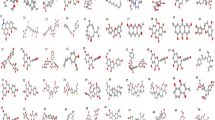Abstract
Fluoroquinolines, the widely used antibacterial antibiotics, have been shown to interact with human DNA topoisomerases supporting their use as repurposed cancer drugs in humans. In this communication molecular docking of eleven Fluoroquinolines against predicted structure of Candida albicans DNA Topoisomerase II is reported for the first time. C. albicans topoisomerase II structure prediction was done by using homology modeling tool. Ligand preparation and molecular docking with C. albicans topoisomerase II were done by using Autodock tool. These antibiotics formed hydrogen bond with good binding affinity at ARG 841, GLN803, ALA840 amino acid residues in the active site of C. albicans Topoisomerase II. We hypothesize that DNA toposiomerases may be the targets of Fluroquinoline group of antibiotics in C. albicans causing inhibition of growth.













Similar content being viewed by others
References
Aldred J, Kerns J, Osherof N (2014) Mechanism of quinolone action and resistance. Biochemistry 53:1565–1574
Anand S, Somasundaram S, Doble M, Paramasivan C (2011) Docking studies on novel analogues of 8 methoxyfluoroquinolones against GyrA mutants of Mycobacterium tuberculosis. BMC StructBiol 11(1):1–13
Bertozzi D, Iurlaro R, Sordet O, Marinello J, Zaffaroni N, Capranico G (2011) Characterization of novel antisense HIF-1α transcripts in human cancers. Cell Cycle 10(18):3189–3197
Bertozzi D, Marinello J, Manzo S, Fornari F, Gramantieri L, Capranico G (2014) The natural inhibitor of DNA topoisomerase I, camptothecin, modulates HIF-1α activity by changing miR expression patterns in human cancer cells. Mol Cancer Ther 13(1):239–248
Deren Y, Özdek S, Kalkanci A, Akyürek N, Hasanreisoglu B (2010) Comparison of antifungal efficacies of moxifloxacin, liposomal amphotericin B, and combination treatment in experimental Candida albicansendophthalmitis in rabbits. Can J Microbiol 56(1):1–7
Drwal MN, Agama K, Pommier Y, Griffith R (2013) Development of purely structure-based pharmacophores for the Topoisomerase I-DNA-ligand binding pocket. J Comput Aided Mol Des 27(12):1037–1049
Hande K (2008) Topoisomerase II inhibitors. Update Cancer Ther 3(1):13–26
Jadhav A, Karuppayil M (2017) Molecular docking studies on thirteen fluoroquinolines with human topoisomerase II a and b. In Silico Pharmacol 5(1):1–12
Jadhav A, Bansode B, Phule D, Amruta S, Rajendra P, Gade W, Kharat K, Karuppayil M (2017) The antibacterial agent, moxifloxacin inhibits virulence factors of Candida albicans through multitargeting. World J MicrobiolBiotechnol 33(5):1–9
Keating G, Scott L (2004) Moxifloxacin. Drugs 64(20):2347–2377
Kelley L, Mezulis S, Yates C, Wass M, Sternberg M (2015) The Phyre2 web portal for protein modeling, prediction and analysis. Nat Protoc 10(6):845–858
Kumar A, Bora U (2014) Molecular docking studies of curcumin natural derivatives with DNA topoisomerase I and II-DNA complexes. InterdiscipSciComput Life Sci 6(4):285–291
Kwok S, Schelenz S, Wang X, Steverding D (2010) In vitro effect of DNA topoisomerase inhibitors on Candida albicans. Med Mycol 48(1):155–160
Laskowski R, MacArthur M, Thornton JM (2001) PROCHECK: validation of protein structure coordinates. In: International tables of crystallography, vol F. Crystallography of biological macromolecules. Kluwer Academic Publishers, The Netherlands, pp 722–725
Maraki S, Lionakis S, Ntaoukakis M, Barbounakis E, Ntasis E, Kofteridis D, Samonis G (2011) Effects of levofloxacin, moxifloxacin and prulifloxacin on murine gut colonization by Candida albicans. Med Mycol 49(4):419–423
Mdluli K, Ma Z (2007) Mycobacterium tuberculosis DNA gyrase as a target for drug discovery. Infect Disord Drug Targets 7(2):159–168
Morris G, Goodsell D, Halliday R, Huey R, Hart W, Belew R, Olson A (1998) Automated docking using a Lamarckian genetic algorithm and an empirical binding free energy function. J ComputChem 19(14):1639–1662
Nitiss JL (2009) Targeting DNA topoisomerase II in cancer chemotherapy. Nat Rev Cancer 9:338–350
Ozdek S, Miller D, Flynn P, Flynn H (2006) In vitro antifungal activity of the fourth generation fluoroquinolones against Candida isolates from human ocular infections. Ocular ImmunolInflamm 14(6):347–351
Pommier Y (2013) Drugging topoisomerases: lessons and challenges. ACS ChemBiol 8:82–95
Shalit I, Horev-Azaria L, Fabian I, Blau H, Kariv N, Shechtman I, Kletter Y (2002) Immunomodulatory and protective effects of moxifloxacin against Candida albicans-induced bronchopneumonia in mice injected with cyclophosphamide. Antimicrob Agent Chemother 46(8):2442–2449
Skok Z, Zidar N, Kikelj D, Ilaš J, (2020) Dual inhibitors of human DNA topoisomerase II and other cancer-related targets. J Med Chem 63:884–890
Stergiopoulou T, Meletiadis J, Sein T, Papaioannidou P, Tsiouris I, Roilides E, Walsh T (2009) Comparative pharmacodynamic interaction analysis between ciprofloxacin, moxifloxacin and levofloxacin and antifungal agents against Candida albicans and Aspergillus fumigatus. J AntimicrobChemother 63(2):343–348
Steverding D, Evans P, Msika L, Riley B, Wallington J, Schelenz S (2012) In vitro antifungal activity of DNA topoisomerase inhibitors. Med Mycol 50(3):333–336
Wang S, Miller W, Milton J, Vicker N, Stewart A, Charlton P, Denny WA (2002) Structure–activity relationships for analogues of the phenazine-based dual topoisomerase I/II inhibitor XR11576. Bioorg Med Chem Lett 12(3):415–418
Yalcin B, Kalkanci A, Gürelik F, Fidan I, Kustimur S, Ozdek S (2010) In vitro synergistic effect of moxifloxacin and amphotericin B combination against Candida strains. MikrobBult 44(1):65–70
Acknowledgements
AKJ and SMK is thankful to DY Patil Education Society (Deemed to be University), Kolhapur, 416006, Maharashtra, India for providing funding support for Research.
Author information
Authors and Affiliations
Corresponding author
Additional information
Publisher's Note
Springer Nature remains neutral with regard to jurisdictional claims in published maps and institutional affiliations.
Rights and permissions
About this article
Cite this article
Jadhav, A.K., Karuppayil, S.M. Topoisomerase II as a target for repurposed antibiotics in Candida albicans: an in silico study. In Silico Pharmacol. 9, 24 (2021). https://doi.org/10.1007/s40203-021-00082-1
Received:
Accepted:
Published:
DOI: https://doi.org/10.1007/s40203-021-00082-1




